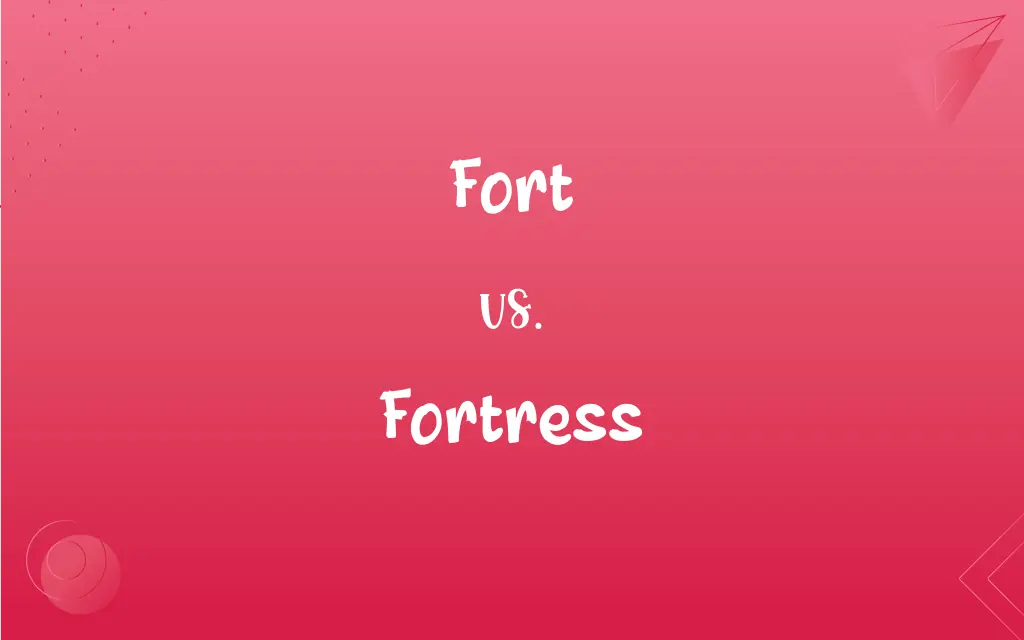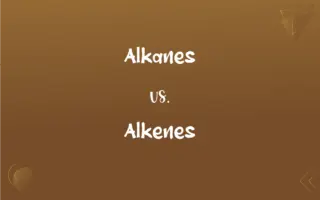Fort vs. Fortress: What's the Difference?
Edited by Janet White || By Harlon Moss || Updated on October 16, 2023
A fort is a fortified building or military post, whereas a fortress is a large and permanent fortification often encompassing a town or city.

Key Differences
A fort typically refers to a smaller, fortified location, usually a military post or stronghold, designed primarily for defense. On the other hand, a fortress implies a much larger structure, often encompassing extensive grounds, walls, and buildings.
While both fort and fortress are constructed with defense in mind, a fortress's vast size often allows it to serve as a safe haven for civilians during times of conflict, unlike a fort which is more military-centric.
Historically, a fort might be established at strategic points like trade routes, river crossings, or borders. A fortress, due to its larger scale, might be constructed to dominate and protect an entire city or region.
Both fort and fortress have played pivotal roles in warfare and protection throughout history. However, while a fort might be seen as a temporary or transitional military structure, a fortress is often perceived as a permanent establishment and a symbol of enduring strength.
In terms of construction, a fort can be a relatively quick setup, especially if it's meant to serve short-term purposes. In contrast, building a fortress involves more extensive planning, resources, and time, reflecting its permanence and importance.
ADVERTISEMENT
Comparison Chart
Basic Definition
A fortified building or military post.
A large and permanent fortification.
Size
Smaller.
Larger, can encompass a town or city.
Primary Function
Defense and military operations.
Defense, protection, and sometimes administrative.
Duration & Construction
Can be temporary or transitional.
Permanent, with extensive planning and construction.
Relationship with Civilians
Primarily military-centric.
Can serve as a safe haven for civilians.
ADVERTISEMENT
Fort and Fortress Definitions
Fort
A military post where troops are stationed.
The fort was established to monitor the border activities.
Fortress
An imposing structure encompassing extensive grounds and defenses.
The fortress was surrounded by a wide moat.
Fort
A secure place fortified against attack.
The treasure was hidden inside the fort.
Fortress
A large, fortified place built for long-term defense.
The city's fortress has stood for over five centuries.
Fort
A base from which military activities are coordinated.
Intelligence reports were sent directly to the fort.
Fortress
A major stronghold that dominates and protects a region.
The fortress overlooked the entire valley.
Fort
A fortified building designed for defense.
The soldiers retreated to the fort for protection.
Fortress
A vast establishment combining military and civilian structures.
Inside the fortress, there were markets, homes, and churches.
Fort
A stronghold established at strategic points.
The fort guarded the main river crossing.
Fortress
A symbol of enduring strength and protection.
The fortress served as a reminder of the empire's might.
Fort
A fortified place or position for the stationing of troops.
Fortress
A fortified place, especially a large, permanent military stronghold that often includes a town.
Fort
A permanent army post.
Fortress
A fortified place; a large and permanent fortification, sometimes including a town; for example a fort, a castle; a stronghold; a place of defense or security.
FAQs
What is a fort?
A fort is a fortified building or military post designed for defense.
Are all forts temporary?
No, while some forts are temporary, others can be permanent structures.
How are forts different from castles?
While both are fortified structures, forts are primarily military, while castles can also be residences and symbols of authority.
What defines a fortress?
A fortress is a large, permanent fortification, often encompassing a town or city.
Can a fortress be a tourist attraction?
Absolutely, many ancient fortresses are popular tourist destinations due to their historical significance.
Were fortresses only built on land?
While most are on land, some fortresses were built on waterways or coastal areas for naval defense.
Is every fortress a fort?
Yes, every fortress can be considered a fort, but not every fort is a fortress due to size and permanence.
Can a fort be moved?
Some forts, especially those meant for short-term use, can be dismantled and moved, but many are permanent.
Are forts and fortresses made only of stone?
No, they can be made of various materials, including wood, earth, and modern materials, depending on their purpose and era.
Do all countries have forts and fortresses?
Most countries have some form of forts or fortresses, reflecting their historical needs for defense and strategy.
What might you find inside a fortress?
A fortress might contain barracks, armories, administrative buildings, homes, markets, and places of worship.
Why were forts built historically?
Forts were built for defense, controlling strategic points, and military operations.
Can civilians live inside a fortress?
Yes, fortresses often provide protection for civilians and may include residential areas.
Is a fort always smaller than a fortress?
Typically, yes; a fort is usually smaller while a fortress implies a larger structure.
What is the main function of a fortress?
A fortress's main function is long-term defense, protection, and sometimes administrative purposes.
Were forts and fortresses only built in ancient times?
While many famous forts and fortresses are ancient, they have been built throughout history and even in modern times for various purposes.
Are forts and fortresses obsolete in modern warfare?
Modern warfare has evolved, but forts and fortresses can still have strategic value in certain contexts.
How long does it take to build a fortress?
Building a fortress can take years or even decades, depending on its size and complexity.
Who lived inside forts?
Forts primarily housed soldiers, military officials, and sometimes their families.
How were fortresses protected?
Fortresses employed walls, moats, towers, gates, and other defensive features to deter attackers.
About Author
Written by
Harlon MossHarlon is a seasoned quality moderator and accomplished content writer for Difference Wiki. An alumnus of the prestigious University of California, he earned his degree in Computer Science. Leveraging his academic background, Harlon brings a meticulous and informed perspective to his work, ensuring content accuracy and excellence.
Edited by
Janet WhiteJanet White has been an esteemed writer and blogger for Difference Wiki. Holding a Master's degree in Science and Medical Journalism from the prestigious Boston University, she has consistently demonstrated her expertise and passion for her field. When she's not immersed in her work, Janet relishes her time exercising, delving into a good book, and cherishing moments with friends and family.































































